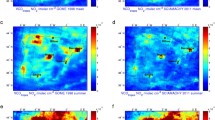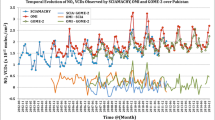Abstract
The influence that megalopolises have on the atmospheric composition on regional and global scales is the subject of intense investigations; however, data on the emissions of pollutants used for such investigations are often insufficiently reliable. In this work the possibilities for diagnosing long-term changes in nitrogen oxide emissions in megalopolises are investigated based on a combined use of data from satellite measurements and modeling of the tropospheric nitrogen dioxide content. Primary emphasis is placed on analyzing possible situations when emission changes are of a nonlinear character. The proposed methodology includes an original method for the nonlinear approximation of changes in a physical quantity from a noised time series of its measurements. Changes in NO x emissions are investigated in 12 megalopolises of Europe and the Middle East in the period from 1996 to 2008. Statistically significant changes in NO x emissions are detected in five megalopolises (Baghdad, Madrid, Milan, Moscow, and Paris). By using three megalopolises (Madrid, Milan, and Paris) as an example, it is shown that a nonlinear approximation of NO x emission changes agrees better with independent ground-based measurements than an analogous linear approximation.
Similar content being viewed by others
References
M. J. Molina and L. T. Molina, “Megacities and Atmospheric Pollution,” J. Air Waste Manag. Assoc. 54(6), 644–680 (2004).
M. G. Lawrence, T. M. Butler, J. Steinkamp, et al., “Regional Pollution Potentials of Megacities and Other Major Population Centers,” Atmos. Chem. Phys. 7, 3969–3987 (2007).
T. M. Butler, M. G. Lawrence, B. R. Gurjar, et al., “The Representation of Emissions from Megacities in Global Emission Inventories,” Atmos. Environ. 42, 703–719 (2008).
A. Richter, J. P. Burrows, H. Nu, et al., “Increase in Tropospheric Nitrogen Dioxide over China Observed from Space,” Nature 437, doi: 10.1038/nature04092 (2005).
I. B. Konovalov, “Regional Differences in Decadal Changes of the Atmospheric Emissions of Nitrogen Oxides in the European Part of Russia: Results of Inverse Modeling Based on Satellite Data,” Dokl. Akad. Nauk 417(5), 685–688 (2007).
I. B. Konovalov, M. Beekmann, J. P. Burrows, et al., “Satellite Measurement Based Estimates of Decadal Changes in European Nitrogen Oxides Emissions,” Atmos. Chem. Phys. 8, 2623–2641 (2008).
S.-W. Kim, A. Heckel, G. J. Frost, et al., “NO2 Columns in the Western United States Observed from Space and Simulated by a Regional Chemistry Model and Their Implications for NOx Emissions,” J. Geophys. Res. 114, D11301 (2009).
J. C. Moore, A. Grinsted, and S. Jevrejeva, “New Tools for Analyzing Time Series Relationships and Trends,” EOS, Transact. Amer. Geophys. Union 86(24), 226–232 (2005).
R. Shalkoff, Pattern Recognition: Statistical, Structural and Neural Approaches (Wiley, New York, 1991).
M. W. Gardner and S. R. Dorling, “Artificial Neural Networks (the Multilayer Perceptron)-A Review of Applications in the Atmospheric Sciences,” Atmos. Environ. 32(14/15), 2627–2636 (1998).
I. B. Konovalov, “Application of Neural Networks for Studying Nonlinear Relationships between Ozone and Its Precursors,” J. Geophys. Res.-Atmos. 107(4122) (2002).
I. B. Konovalov, “Nonlinear Relationships between Atmospheric Aerosol and Its Gaseous Precursors: Analysis of Long-Term Air Quality Monitoring Data by Means of Neural Networks,” Atmos. Chem. Phys. 3, 607–621 (2003).
K. Hornik, M. Stinchcombe, and H. White, “Multilayer Feedforward Networks Are Universal Approximators,” Neuron Networks 2(1), 359–366 (1989).
A. Tarantola, Inverse Problem Theory; Methods for Data Fitting and Model Parameter Estimation (SIAM, Philadelphia, 2004).
I. G. Enting, Inverse Problems in Atmospheric Constituents Transport (Cambridge Univ. Press, Cambridge, 2002).
W. H. Press, S. A. Teukolsky, W. T. Vetterling, et al., Numerical Recipes 3d Edition: The Art of Scientific Computing (Cambridge University Press, Cambridge, 2007).
J. A. Nelder and R. Mead, “A Simplex Method for Function Minimization,” Comp. J. 7(4), 308–313 (1965).
J. P. Burrows, M. Weber, M. Buchwitz, et al., “The Global Ozone Monitoring Experiment (GOME): Mission Concept and First Scientific Results,” J. Atmos. Sci. 56(2), 151–175 (1999).
H. Bovensmann, J. P. Burrows, M. Buchwitz, et al., “SCIAMACHY-Mission Objectives and Measurement Modes,” J. Atmos. Sci. 56(2), 127–150 (1999).
I. B. Konovalov, M. Beekmann, A. Richter, et al., “Inverse Modelling of the Spatial Distribution of NOx Emissions on a Continental Scale using Satellite Data,” Atmos. Chem. Phys. 6, 1747–1770 (2006).
R. Vautard, P. H. J. Builtjes, P. Thunis, et al., “Evaluation and Intercomparison of Ozone and PM10 Simulations by Several Chemistry Transport Models over Four European Cities within the CityDelta Project,” Atmos. Environ. 41(1), 173–188 (2007).
I. B. Konovalov, M. Beekmann, R. Vautard, et al., “Comparison and Evaluation of Modelled and GOME Measurement Derived Tropospheric NO2 Columns over Western and Eastern Europe,” Atmos. Chem. Phys. 5, 169–190 (2005).
I. B. Konovalov, N. F. Elanskii, A. M. Zvyagintsev, et al., “Validation of Chemistry Transport Model of the Lower Atmosphere of the Central European Region of Russia using Ground-Based and Satellite Measurement Data,” Meteorol. Gidrol., No. 4, 65–74 (2009).
Author information
Authors and Affiliations
Corresponding author
Additional information
Original Russian Text © I.B. Konovalov, 2011, published in Izvestiya AN. Fizika Atmosfery i Okeana, 2011, Vol. 47, No. 2, pp. 220–229.
Rights and permissions
About this article
Cite this article
Konovalov, I.B. Estimation of multiyear changes in nitrogen oxide emissions in megalopolises from satellite measurements. Izv. Atmos. Ocean. Phys. 47, 201–210 (2011). https://doi.org/10.1134/S0001433811020058
Received:
Accepted:
Published:
Issue Date:
DOI: https://doi.org/10.1134/S0001433811020058




